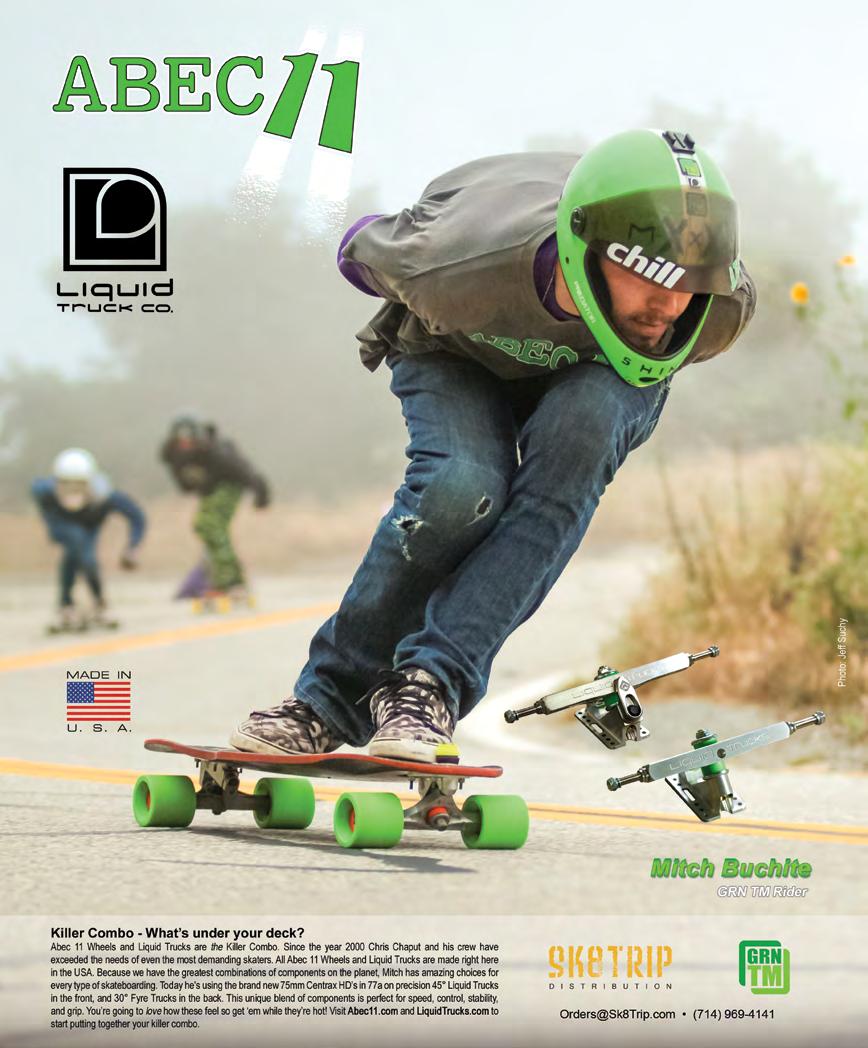






















































































CONTENTS:




Meet “Ed.” He’s the creation of Richmond Hill, Ontario, artist Daniel Marlatt. How “Ed” wound up in the Fine Print is rather unusual. Since this is the 15th anniversary issue, I am going to ask you to indulge me while I share the tale. Back in mid-April my wife and I were wondering what to do one Saturday afternoon. Spring was definitely on its way, but it was certainly indoor weather. After a little bit of deliberation, we decided on visiting the local artists’ gallery. Though we’ve lived about 15 minutes from this gallery for years, neither of us had ever set foot inside.
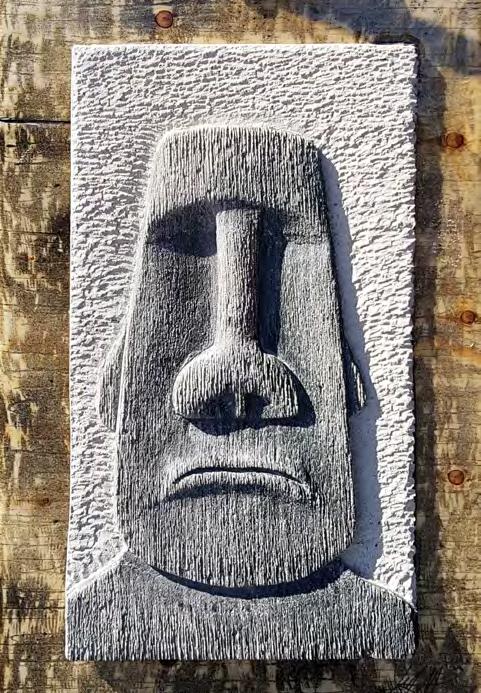
We were both intrigued and delighted by what we encountered, and we found that we both liked the same two pieces of art. Both artists also happened to be in the gallery – talk about a nice coincidence. I got a chance to chat with Daniel and we exchanged business cards. After about two weeks, we met up and I learned a little more about “Ed” and Daniel’s life.
It turns out that “Ed” is made from scraps. Daniel, a self-taught artist, uses drywall that is reclaimed. Through his remarkable talent, Daniel brings something to life that most would consider to be junk. After getting to know Daniel and hearing how many people came close to buying “Ed,” I wound up purchasing “him” that very day. I consider it a very worthwhile investment, and I am now working with other artists in Richmond Hill to see how we can expose their truly worthwhile art to more people.
As skaters, many times we find ourselves enjoying something that most have ignored or can’t see the potential in. To this day, if I am driving and I spy what looks like a killer spot, I’ll make a comment and mental note to revisit. Somehow, seeing the potential of what could be ridden spills over into things like experiencing art, music and even food. It’s important to keep an open mind, because you just never know what’s around the corner.
But this is not the end of the story. You see, for the first week in May, I was working on a new concept I call “The Purple and Gold Hive.” This hive idea grew out of another idea I’ve just created called “The Magic of Balance.” My concept is to build a network of hives around the world. I can’t really explain why, but if it works for bees, then it must have some merit for humans.
When I met with Daniel, I showed him my PowerPoint presentation that featured these hexagonal images. He laughed and then pulled out his cellphone and showed me what he was working on: a piece he calls “The Hive” that uses the same reclaimed drywall that brought “Ed” to life. Turns out that art, skateboarding and collaboration eventually bring you to the same wavelength. But then again, if you’ve read this far, you already knew that. Thank you to everyone who has supported CW through the years. It’s truly been a collaborative effort. Here’s to you all!




This Summer, Dusters California collaborates with one of the most compelling groups of visual artists working in Los Angeles today, the California Locos. Five pioneering artists whose roots are in graffiti, surf, skate, punk, rock, as well as the contemporary art world, together and separately, embody the innovative, lively and rebellious spirit of Los Angeles through these five distinctive Dusters skateboards. For more information please visit us at www.dusterscalifornia.com.


is a mirage... the LOCOS are a manifestation of the mirage...
Although this editorial marks Vol. 15 No. 1, I am about to hit three decades in publishing – hard to believe. I got started in 1988, when I set up something called Freestyle International. It wasn’t much, but about 100 skaters were able to communicate with each other through the mail. We produced a few fanzines and got written up in both Transworld and Thrasher
Back in 1995 or so, my brother Andrew helped me set up the Skategeezer Homepage. That $5-a-month website led to a book contract and eventually a 52-part TV series called Concrete Wave. Along the way, numerous people have contributed to the magazine. There is simply not enough space to list all of them here, but I am grateful to all those who have supported the vision of skateboarding found within these pages and beyond. Here are some of my memories of the last two decades.
It was Mike Moore who came up with the logo for the Skategeezer Homepage. Mike’s logo still resonates. From there, it was a quick leap to Todd Huber of Skatelab. Thanks to his fanzine, Skate Trader, I was awakened to the possibilities of longboarding and the cool nostalgia surrounding skateboarding. From there, things started rolling quickly. I wound up getting a book contract to write the history of skateboarding. The Concrete Wave came out the same year as I co-founded International Longboarder Magazine, which I put together with Tom Browne. I had ridden Tom’s G&S Fibreflex back in 1976 in London, Ontario, and over 20 years later we were collaborating on a magazine.

In 2002, I launched Concrete Wave magazine. As he had done six years previously, Mike Moore contributed. His phrase “taking you back and moving you forward” became the key idea in that first editorial. When you compare where we are now in the skate world to where we’ve come from, it’s hard to believe it’s the same industry. Twenty years ago, the idea of something other than a popsicle shape with 99A durometer wheels was pretty much inconceivable to most people. In this issue, we celebrate the work of Randal Fuller. If you ride a reverse-kingpin truck, you can thank Randal. He made his first such trucks back in the mid-1970s. Other visionaries like Michael Bream of Gravity created the world’s first slide contest and featured women in ads and marketing materials way back when. Fastforward to this issue and Candy Dungan is writing about gear specifically made for female riders. We’re also proud to feature the stories of female skate pioneers like Di Dootson and Courtney Payne-Taylor. As I look toward the future, I know the world of skateboarding will continue to bring joy to millions of people throughout the world. It is indeed a privilege to work in this business.

Here’s to the ride and concrete waves!
Michael Brooke Publisher/EditorPS: Perhaps the most unusual way to mark the passage of time is to look at some of the quite young people we’ve featured in the mag. Have a peek at the Daddies ad that features the original owner Melanie Loveland’s grandchildren. Now, fast-forward a decade












With a versatile stature, impeccable style and a ready-to-rock attitude, the Skiff was designed for all-terrain use. The 62 mm x 35 mm Skiff is a utilitarian alternative to a traditional street wheel for riding faster, steeper, rougher and longer. The pink AF core is 35 mm x 38 mm and has a deep, valley-shaped cross section that keeps the rounded lips firmly supported, promoting smooth, consistent slides and even wear. The stone-ground contact patch ensures predictable and buttery slides right out of the box. orangatangwheels.com
Who can deny a shortcut in life? The quick route to work, microwave instead of the oven, instant coffee vs. drip or a peek at your classmate’s algebra homework. Whatever your fast lane to success, finally here’s a shortcut you don’t have to feel guilty about: Kebbek’s new complete mini cruiser, the Short Cut. Featured with another graphic from this year’s iconic SkateHouse Series. kebbek.com
Arsenal Trucks announces the release of their new 152 mm and 162mm precision longboard trucks. The line of Arsenal cast trucks will now be available in blue and red colorways in limited quantities. All Arsenal trucks have a lifetime warranty. When Moonshine Manufacturing wanted to begin offering a 30day, no questions asked, money back guarantee on their completes, they turned to Arsenal as the truck of choice. Arsenal Trucks are sold in 26 countries and counting. arsenaltrucks.com



After a recent move to Golden, Colorado, Pantheon Longboards has been hard at work getting life and the new lineup together. The 2016 Logos has an all-new mold, combining rocker, sweeping flares, crescent drops and a comfortable concave for a do-it-all freeride, freestyle, downhill and spiritual experience. pantheonlongboards.com

The new Jet Potato series is landing in shops this June. Potatoes feature a compact size with maximum impact, allowing skaters to slay it in any discipline. The Potato series decks are pressed in five unique precision molds and are constructed with the finest hardwoods and adhesives available. Each deck is handcrafted in the USA using contours and shapes designed by Jet team riders. jetskateboards.com

GN4LW has teamed up with Dusters California to create a cruiser skateboard that projects the female empowerment skateboarding brings to girls and women alike. The “It’s Not About Pretty” skateboard reminds us that girls are not just a pretty face and should strive for so much more in today’s world. This is one in a long line of Dusters and GN4LW collaborations from which a portion of the sales benefit a 501(c) (3) nonprofit that creates exposure and opportunities for girls in skateboarding. This year’s recipient is EXPOSURE Skate.

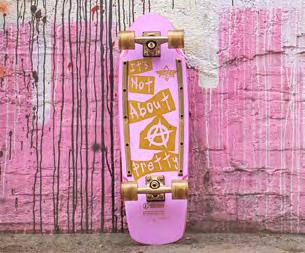
dusterscalifornia.com
SEISMIC
Seismic introduces a new and improved construction of its patented Tekton self-aligning bearing technology. The original construction featured a broad flange integrally machined on the end of the inner race extension, which made factory assembly operations more challenging. Starting this summer, Tekton 6-Ball, 7-Ball and Ceramic bearings will feature precision anodized flange pieces press-fit to the bearing body in the final stage of assembly. The result is a triple win: The bearings look better, with color-anodized flanges precision-machined from 6061 heat-treated aluminum. They self-align better inside your wheels, due to the larger flanges. And they perform better, due to tighter assembly tolerances. seismicskate.com
In other Dusters news, the company is joining forces with one of the most compelling group of visual artists working in Los Angeles today, the California Locos. They are five pioneering artists whose roots are in graffiti, surf, skate and punk rock, as well as the contemporary art world. Chaz Bojórquez, Dave Tourjé, John Van Hamersveld, Norton Wisdom and Gary Wong, together and separately, embody the innovative, lively and rebellious spirit of Los Angeles. Led by creative director Nano Nobrega, the Locos bring their edgy, sun-soaked styles to an even larger audience by collaborating on five distinctive Dusters cruisers designed to represent each one of them as diversely as the city itself. dusterscalifornia.com
The U.S. Patent and Trademark Office has issued two patents to Seismic – the first for its Aeon bushing truck, and the second for its Tekton self-aligning bearing system. Tubular channels in the Aeon bushings wrap around barrel-shaped features on the Aeon hanger to stabilize the steering axis and eliminate “lateral slop” – resulting in noticeably cleaner, smoother, deeper turns. Tekton bearings feature broad flanges at the ends of integral half-spacers that square up, co-align and self-stabilize inside your wheels. The result is faster and more precise roll; more consistent wheel contact and grip while cornering; more predictable slide release and hookup; and longer wheel and bearing life.



New for 2016, the Landyachtz Dinghy 24 is their smallest board to date. This reliable little ripper is the board you can take anywhere with you. The deck is made from 100% Canadian maple, comes with Bear trucks and Hawgs wheels and is available in two graphics. landyachtz.com

The goal of the new HD Wheels series was to take Reflex Formula BigZigs and Centrax and increase the roll speed, traction and control and smooth out the slides. By using a bigger core, thickening the lips and pouring them in softer 74A and 77A duros, the new HD Series have become the new standard in downhill racing wheels. Each size wheel comes in both an offset BigZig and a centerset Centrax footprint. The 75 mm BigZig HD and Centrax HD are ready to roll, with the 71 mm BigZig/Centrax HD and the 83 mm BigZig/ Centrax HD being slated for release this summer. abec11.com

Freeriding has always been a core element of Women’s Longboard Camp, and organizers are stoked to bring participants a dedicated freeride event in August 2016. There is a mini ramp, two closed freeride tracks, a platform offering plenty of space for freestyle action by day and stargazing by night, and more. Teaming up with Woodwings, the camp welcomes all skaters regardless of level or ability. Whether you want to get your slide on, learn some longboard dance moves or a few freestyle tricks, or if you’d like to get a taste for speed, you owe yourself a visit to Aillon-le-Vieux in Southern France. womenslongboardcamp.com
Bob Ballou, founder of legendary skate company Powerflex, along with his brothers, has teamed up with former pro skater Jim Gray to bring fun, color and a different perspective back to the skateboard market. For many the Powerflex 5 will bring back memories of a great skate childhood, and a new fun addition to the quiver for others. Its size and shape are perfect for sidewalk and street charging. The wheel comes in 88A and 96A. Look for them on Facebook or at powerflexskateboards.com
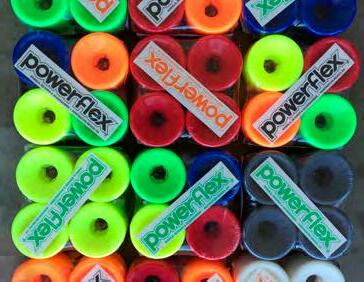
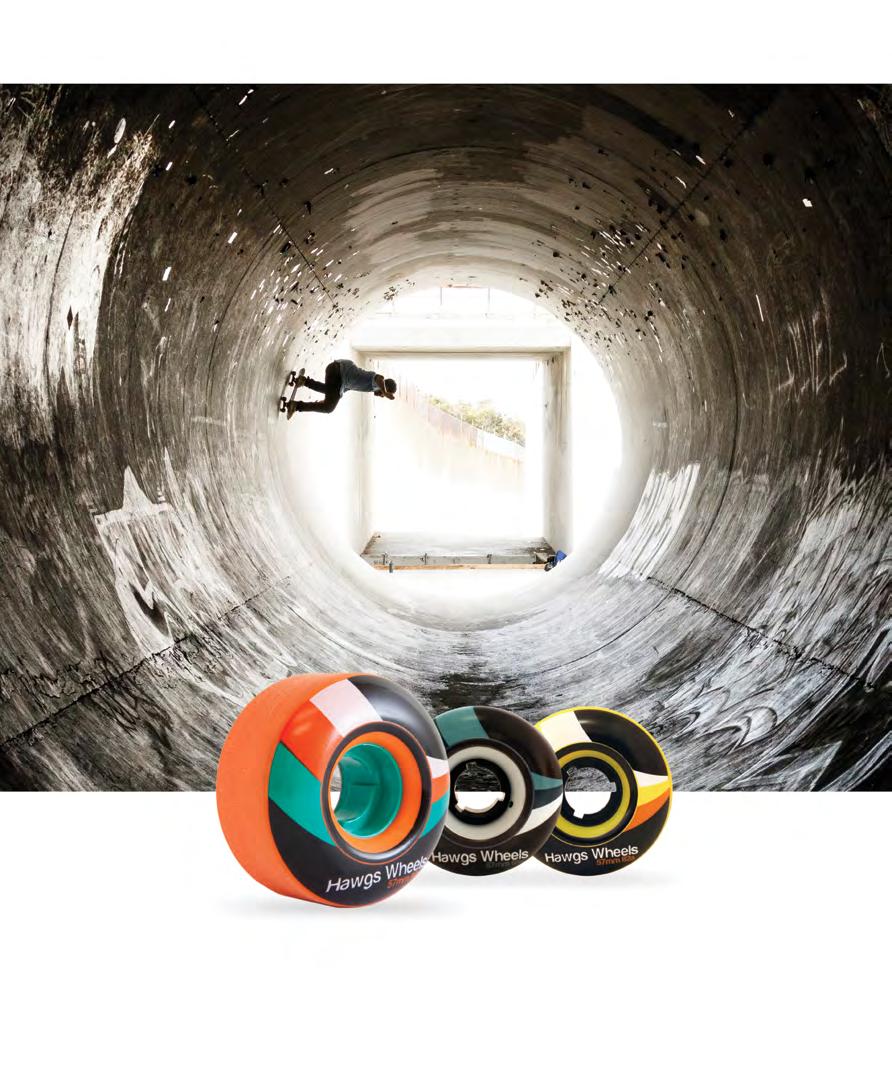
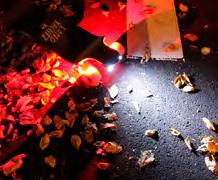
Introducing El Capitan of carve. The 35.75” El Jefe locks in your feet, thanks to Never Summer’s W concave, while its snappy yet powerful flex lets you arc huge carves like a boss. This is the perfect cruiser with a functional kicktail. neversummer.com

Torpedo Lights Mark IV is a premium, compact, durable skate headlight system with innovative sidelights. Constructed of chromoly steel, it is water-resistant, rechargeable via micro-USB, and the light lasts for 6 hours of continuous use. The Mark IV transforms night skating into both a safer and more immersive experience. Get yours by supporting their Kickstarter campaign this July. ekicktech.com

Shark Wheel has three new releases for summer. The 70 mm, 78A Sidewinder features a new and improved formula for all-around freeriding and cruising. The 70 mm, 80A Mako is great for fast freeriding and learning how to slide. The 60 mm, 78A California Roll is their most versatile wheel, with a compact heightto-width ratio for maximum grip. sharkwheels.com


The Sucrose Initiative has another great freeride wheel on the market, designed for skating it all. The Spud is a centerset 64 mm wheel with the perfect mix of quick acceleration and roll speed. This wheel is great for double-kick shapes and all sizes of downhill boards and is available in red, white or blue. The Spud is 64 mm by 36.5 mm with a durometer of 82A. The stone-ground finish on the Spud improves slide performance and makes for a very fun ride. arborcollective.com



Sk8Kings is proud to announce the release of the new SS Gold Series, the latest installment in their Turbo Wheels line. The new SuperSpeed (SS) formula brings a material composition never before used in a skateboard wheel. They are available in two sizes, 70 and 75 mm; two hub versions, CNC aluminum or composite glass; and are 82A durometer in Black Gold colorway. 100% made in the USA. sk8kings.com
The January issue featured a story from Shralpers Union. That story was written by Matthew Williams.


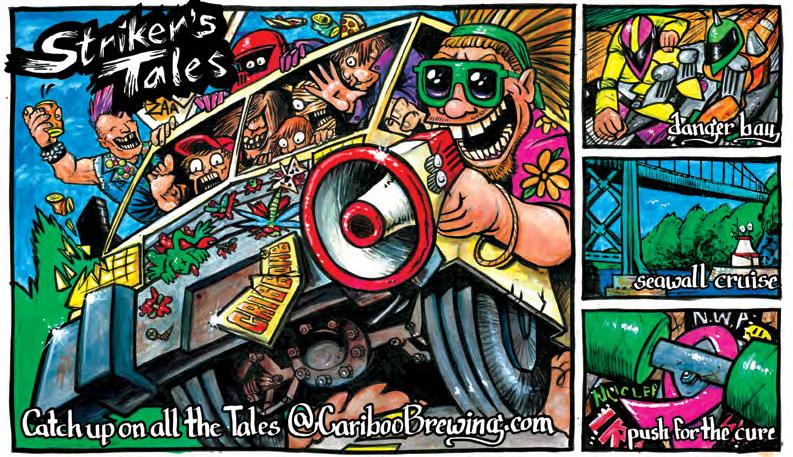




A decade ago, a girl in Indiana had a vision. An unexpected turn of events introduced Courtney Payne-Taylor to skateboarding, and it saved her life. When she started skating, the only girls she saw at skateparks were simply watching. She wondered why there were not more females enjoying the love and benefits of riding. What was keeping them off boards? Changing that reality became a purpose that fueled the desire to stay alive.
It became clear that a few main reasons were keeping girls from becoming skateboarders. They believed they were not capable, that they were alone, and that they were not welcome in the world of skateboarding. GRO was born with the intention to change these beliefs.
GRO started with a girl in a van filled with skateboards, pads and helmets. Courtney traveled the country coast to coast. She provided free workshops to girls of all ages who were willing to take that first step onto a board. Through supportive instruction, becoming comfortable with the basics, girls quickly realized they were capable. By adding each girl into a network of other girls just like her, they began to see they were not alone.

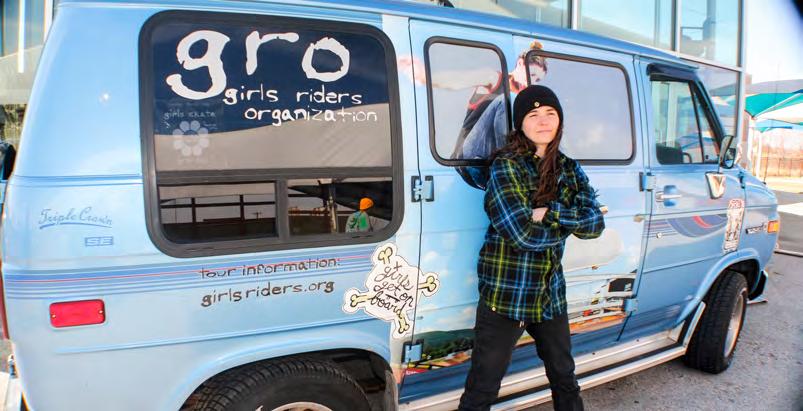
They were welcome and were part of something.
Girls were getting on board everywhere. This enthusiasm presented the need to build communities with regular, ongoing support. It was more than one girl in a van could do on her own. To truly grow communities of girl riders, it would take many girls becoming local leaders of the GRO mission. Girls loved the idea.
GRO founder Courtney Payne-Taylor GRO aims to welcome girls to skateboarding. This 2013 meet-up in Dallas seems to have succeeded. Photo: Ruby TullHowever, many girls believed they were not capable of leading and that their local skate community would not welcome them in this role. This was holding them back from becoming the leaders their towns needed.
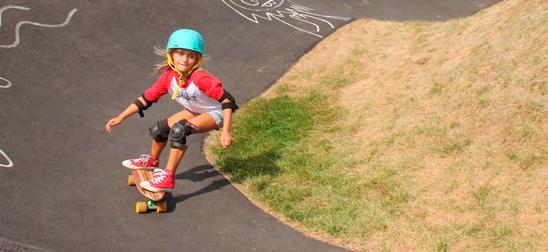
It was time for a shift in GRO. Life on the road and teaching girls to skate gave way to settling in NYC and shifting the focus to provide a network that could teach girls to be leaders. In order to develop the network for crews across the country, Courtney needed to get off the road. She moved to NYC, whose skate culture is persistent through the weather and the city’s tough, broken streets. It is also a city where people continuously make their innovative dreams a reality, which goes hand and hand with the GRO mission. One by one, girls began to step into leadership roles, developing local GRO Crews where they lived. Through this, they soon learned that they were not only able to lead this growth, they were amazing at doing so. Those who began crews without local support developed a strong network through the girls and parents that joined.
This year, as GRO celebrates 10 years of empowering girls through action sports, the question is, “What’s next?” Girls can ride. Girls can lead. It’s time to show how their dreams, ideas and imagination can further change our world.
GRO began with one girl. It has grown through many girls and will continue to grow, fueled by many more girls still to come. Together, we make the world of our dreams come true. You may be the girl that ignites the next great idea. GRO knows you are capable and welcomes you with open arms. Join the GRO Riders through girlsriders.org and be part of the next 10 years of positive change!
At 9 years old, Zoe Herishen loved being a skateboarder. Going to skate parks was a favorite thing to do, but when she did, she noticed that she was usually the only girl there. She was not bothered, but she thought it would be nice to have other girls to bond with over skating. Last year she found about GRO. They were having a girls’ meet-up at Riverside Park in NYC, so Zoe decided to go. Not only did she meet other girl skaters, she
also met GRO founder Courtney PayneTaylor and Katie Andrews, the GRO NYC Crew president. There was an immediate connection with Zoe and the GRO NYC girls. That afternoon Zoe became an official GRO Rider.
Up until then, all events Zoe had attended were specific to either long boards or short boards. As a skater who rode many types of skateboards, Zoe had an idea for an event that would include them all. At the next GRO session, Zoe shared her idea with the GRO NYC Crew, and they loved it. Not only were they going to move forward with the event, they were going to let Zoe lead the planning for Chica de Mayo, the name the she chose for the event.
Imagine being a 9-year-old and having an adult actually listen to one of your ideas and help you turn it into a reality. Zoe was thrilled. When she found out that Courtney wanted her to lead the event, she was proud of herself for having the courage to approach the GRO Crew and pitch her idea. Zoe’s family noticed a change in Zoe since she became a member of GRO NYC. She was becoming more confident, more vocal, more expressive. She was taking chances and becoming even more outgoing.
Event planning seemed to be going easily at the beginning. Sponsors were excited to be involved and the venue was confirmed. Everything seemed to be on track – and then it wasn’t. About a month before the event, one of the main sponsors backed out. Unexpected charges arose, and suddenly the event
was in danger of being canceled. Plenty of sponsors were willing to donate product to raffle, which is wonderful, but when it comes to getting money to cover event venues and other costs, it became difficult.
Once news of possible cancellation got out, the venue offered to lower the price so that the event would not have to be canceled. Jessup Griptape stayed in support of the dream and provided financial support to allow Chica de Mayo to move forward.
Zoe’s story is a prime example of why Girls Riders Organization needs financial support. GRO was able to move forward with a great idea from a 9-year-old girl, but because of financial difficulties, the event was almost canceled. In order to continue empowering girls and actually help them turn their dreams into a reality, we need support from the community. We have the opportunity to reach girls of all ages, but we are stymied by a lack of funds.
Teaching self-confidence is one of the greatest benefits of GRO. GRO helps girls overcome their insecurities by teaching them a sport that helps boost confidence and allows them a safe place to bond with other girls who share a common interest. Through GRO these girls become strong, courageous and confident. Everyone learns that no matter how different they are, they are still amazing!
At 9 years of age, Zoe Herishen is already making a huge difference. Zoe helped organize an event that featured both longboarders and those who ride regular-size decks. Photo: Tracey Barton-HerishenHard to believe that the Randal reverse-kingpin truck is now over four decades old. We had a chance to meet up with Jim Ball and his son Steven of Sure-Grip to catch up on things. Look for the Randal RIII truck hitting shops now.

For those who don’t know the history of Randal, can you give us a brief overview of the last few decades?
Jim Ball: Randy Fuller came to me when I was in located in Lynwood in 1975. [He] had this new design for a longboard truck. No one even knew of longboarding at the time, that is a fact. We helped him design the truck which became the Randal 1. He purchased about 500 units and drove back to Palo Alto. I did not hear much from him for about two years until he came back for more trucks.
The longboard business started to grow. Randy was interested in lugeboarding in complete leathers. If there was a hall of fame for longboarding, Randy Fuller should be the first member. His design was revolutionary at the time and ALL longboard trucks have copied the design. No one deserves more credit than Randy. I know for a fact because we worked with him in 1975 and longboarding didn’t exist then.
What are some interesting things about Sure-Grip that most people in skateboarding don’t know?
We started making roller skate products in 1937 when my grandfather designed a wheel made out of phenolic [resin and fiberglass] with a rubber inlay center that provided more grip than standard wheels at the time – hence the name Sure-Grip. Aside from roller skates, we make all kinds of products here from lounge chairs to pool thermometers. Not our brands, of course, but brands for other people. My grandfather was a tool and die maker for the oil companies here in California, and he felt that he could make a better product for his favorite pastime, roller skating. Obviously we do skateboards as well, and we have been doing that since the ’70s. In the beginning we did have our own brands and our own team or riders; it was a very fun and interesting time. A few things changed and we got out of the business as a brand, but we continued to work with other companies making trucks. I’m sure we at some point worked with just about everyone in skateboarding in one way or another. Since 1937, and four generations later, we are still here, making products for kids and adults all over the world. We are vertical in the manufacturing process from casting the truck to injection molding the pivot cups. Everything is U.S.-made.
Randal trucks have an amazing legacy within the world of longboarding. What is your hope for the Randal RIII?
To continue that legacy for another 40 years. Continuing to
Sure-Grip has been manufacturing for over 75 years, and Randal has been a part of that history for 40 of them. Steven Ball (left) and his father, Jim, are aiming for at least 40 more.develop the basic design. We would love to do the same as the VW Beetle: revolutionary design and keep improving. The design is very strong and ahead of its time; remember, everyone has copied the basic design.
What are some key things that you’ve improved upon for this new release?
Different cushions for a more stable ride, machined cushion sets, machined pivot pin and an all-around beefier design. Big difference compared to the Randal RI and RII.
Why did you purchase Randal Trucks?
We understand customer service, and quality. We are very proud of what we do. I’m very proud of Randal. We purchased Randal to preserve the history and the legacy. As the years go by, others will enter the market and leave the market, but Randal will stay. Dollar for dollar there is no better longboard truck on the market today.
There has been a lot of talk about jobs lately, especially jobs returning from overseas back to America. What’s your take on this?
I don’t have the answers, but I can tell you based on my experiences. It will never happen without help from the government. The duty-free issues are causing the problems; we can’t compete in the U.S. with this type of structure. We can’t compete with the labor rates either. We need the government to slow down imports or at least support U.S. manufacturing with a reasonable duty structure. There’s a reason why the U.S. economy is not producing new jobs in the manufacturing sector. It’s not glamorous work by any means, but it’s what helped build this country, and it’s a shame we don’t have more of it. It’s good honest work.
What are some of your plans as it relates to sponsorship?
Steven: As of now we are taking a more grass-roots approach, starting small and seeing where this goes organically. I want our riders to determine where this goes. I want them to weigh in and make this something special again. I think so far we have done a great job, and I want to keep going in this direction, as I trust the people that we have in place.
Over the years Randal gained a following in many countries. What has been some of the best response you’ve encountered?
Steven: I think this has been the natural progression of things. We see it now more than ever with the help of the Internet. It’s awesome to travel and meet people that somehow know the back-story of Randal. I think that is very special. This is an iconic brand, and I think it still has a place in people’s minds. My only hope is that we can continue this journey and grow skating for many years to come. I don’t think many people know the entire history of Sure-Grip and how it relates to Randal, but I hope we can change that in the future. This brand holds a special place in our company’s history, and we want to keep it for years to come.
When it comes to manufacturing, what gives you the greatest satisfaction?

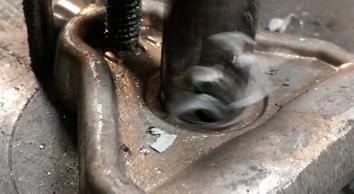
U.S.-made. We can still compete (it’s hard, but we still can) and proud of it. After being in business for over 75 years, we are so very proud. We stand behind everything we make.
 The new RIII adds greater strength and precision machining to the timeless Randal design. “Dollar for dollar, there is no better longboard truck on the market,” says Jim Ball.
The new RIII adds greater strength and precision machining to the timeless Randal design. “Dollar for dollar, there is no better longboard truck on the market,” says Jim Ball.
Welcometo the ShralpLife experience. At the Shralpers Union we have made it our mission to make the world a better place utilizing sidestance board sports. With our motto of “High Fives & Positive Vibes” and our army of dedicated members, we have taken our first steps on this amazing journey. Concrete Wave magazine has given us the opportunity to further our mission of uniting local communities. Here we will be reporting on local scenes, longboarding clubs, our chapters, the mom-and-pop shop and how they all tie in. There will be reports on upcoming events as well as how you can get involved. We will talk about concepts, needs of the communities and what action has been taken. We will take a deep look into what skateboarding is and how it evolved and we’ll explore its roots.

I would like to start with the concept that unites us all: BALANCE. There is no doubt that balance is the key to making things run stable at optimum levels. We know this through our experience in skateboarding. The more balanced you are, the more likely you are to take your skills to the next level. We also know that skateboarding is a perfect example of self-expression and freedom. We strive to show the world the best version of ourselves through relentlessly pushing the envelope – to the point of being an outcast and even labeled as crazy. It is perceived as craziness until the magic happens. For example, when the Mega Ramp first came out, it was perceived as impossible; people thought the riders had to be nuts just to drop in. But through the vision of one person’s passion, a gateway was opened, and once someone finally pulled it off, the
rest followed and progression took place. The uniting factor in this equation was the “Magic of Balance.” With that balance, one can fly through the air, making the impossible happen with true freedom and self expression as the spectators witness something magical. This can be applied to anything in life; after all, it is this balance that will allow your best version to come forth. It is this balance that we need communities to embrace so that we can nurture the next generation of boarders so they can lead by example.
On July 25, 2016, several “Magic of Balance” events will be taking place, and the Union is proud to be on board. Visit shralpersunion.nationbuilder.com to find out what’s happening in your scene and how you can get involved.
On April 9, the Shralpers Union 405 Chapter in Oklahoma City hosted the second annual Stokelahoma, a long-distance push race across several miles of a longer path showcasing the beauty of the city. Upwards of sixty people came out to skate, hang out and volunteer. There were categories for Advanced (14.5 miles) and Beginner (7 miles), as well as a Youth Buttboard race, with prizes for the top three in each category and a Most Stoked award that could go to anyone, even spectators.
Chapter president Harley Waggoner and his wife Bettie organized the event for the second year in a row and knew what to expect. They added the Buttboard race as a way to keep spectators entertained while the longer sprints were taking place, not expecting that it would turn out to be the highlight of their day.
Words: Rachel Floyd
Ifyou’ve ever been to a longboarding race, then you have experienced a special magic. Annual races of various sizes take place across the country (and the globe!), and while each has its own unique flavor, they all have a way of uniting people from every walk of life. A seasoned Shralper knows the excitement that builds up in the weeks before an event, as well as the joy of seeing your skate family on race day. It may be the only time you see some friends in person all year, though the bonds formed on the track tend to run deep, and chances are you’ll be reliving the experience through social media for weeks after.

Several Union chapters have already established yearly events, each with its own flair. We checked with organizers and competitors to bring you the word on a few events that went down in spring 2016.
The Waggoners hope to expand the event in 2017, adding big-air and best trick competitions, as well as more prizes for the kids.
“I love being a Union member,” Harley says. “It’s given me an avenue to help change the stereotype of the average skater, and without trying it’s also helped a lot of people that might not have known about our world discover something truly awesome. Now we’re on a mission to spread those High Fives and Positive Vibes!”
Chase Hiller (open helmet), followed by Brandon Dorn and Levi Mendoza. Photo: Scott Rowe Local Aaron Wallace took first in the Advanced division of the push race, with Ehren Mohammadi from San Antonio, Texas, in second, and local William Megginson in third.“I love being a Union member. It’s given me an avenue to help change the stereotype of the average skater...”
STOKELAHOMA
The Shralpers Union 816 Chapter in Kansas City, Missouri, hosted the third annual King of Kessler on April 23. Sixty-five registered riders and nearly as many spectators and volunteers gathered under beautiful blue skies, a pleasant change from snow in the first year and heavy rain in the second. Event organizers Joseph Burnham and Billy Angus, co-presidents of the chapter and co-founders of Burning Spider Stoke Company, designed the race to test competitors in a variety of styles and to showcase Kessler Park, a Burning Spider favorite.
In order to be crowned King, a rider must earn the highest total overall points in three separate events: a push race, a downhill race and a freeride slide jam. This year’s King of Kessler was Aaron Wallace, who finished with a total of 17 points. He also set a new record for the push race with a time of 20:10. Andrew Atchison took first place in the downhill race, and first place for the slide jam ended in a tie between Chase Hiller and John Pham.
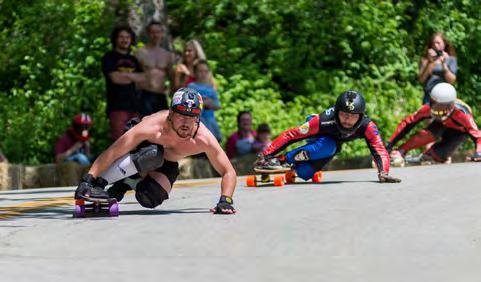



“Kessler Park has been a skate spot from almost the beginning of the skate scene’s organization,” says Burnham. “For many of the guys skating the event it is their first contest; it’s the place they first learn to slide, or get into a tuck. It is their gateway into a wider world.”

Over on the East Coast, about 90 skaters came out on May 14 for the sixth annual Philadelphia Broad Street Bomb, an 8-mile outlaw race through the city. One noticeable change from the event’s early years was the absence of Shralpers Union founder Noel Korman, in whose honor the race is now held.




“Last year was hard,” said organizer and Shralpers Union 215 member Earl Stout III. “It was the first year he hadn’t been there to be a part of it all. He helped out so much!”
Though riders are asked to obey all traffic laws and helmets are required, police interference is always a potential hazard for any outlaw race, and Stout worried that “they may have caught onto us this year.”
Not all changes were negative, though. Keifer Dixon, five-time winner of the race, retired last year, giving new riders a shot at the top spot on this year’s podium. He still came out to show support and take photos. Trophies were a new addition that got skaters even more stoked. This year, Eric “Danger” Palmer took first place, followed by Kyle Yan in second and Josh Bowers in third.
Next year, Stout said he hopes to add an after-party to keep the fun going post-race. Other than that, he says, “Who knows what will happen next year.”
If you want to see what events are going down near you, be sure to check out the Shralpers Union website, shralpersunion.nationbuilder.com, where upcoming races are listed on our Events page. A few to keep in mind for this summer are the Norman Sizzler Outlaw on July 17 in Norman, Oklahoma; and Insanity 2016 on August 27 in Brooklyn, NYC. If you can’t make it to an event (or if you want to learn more about the races in this article), you can find follow-up reviews on the Shralpers Union blog.
About 90 skaters participated in the Broad Street Bomb. Photo: Kiefer Dixon Claudia Clase (left) and Yasmeen Wilkerson enjoy the festivities. Photo: Kiefer Dixon Yasmeen Wilkerson on her way to first place in the women’s division. Photo: Kiefer DixonLongboarding is now the lens by which the Conner family of Anchorage, Alaska, views the world. They eat, drink, breathe and dream longboarding. Their eldest son, Casey, a sophomore in high school, is a youth entrepreneur and owner of 907Boards skate shop. The mom, Lisa, is the creative force and glue of the operation. The father, Dan, stays busy as the fix-it guy and helps with events. Fifth-grader Aaron is enjoying the show and fourth-grade sister Allyson is carving her own lines in longboarding.
 Brad Carter basking in the Northern Lights, Palmer, Alaska. Self-portrait.
Brad Carter basking in the Northern Lights, Palmer, Alaska. Self-portrait.
The dad and kids are lifelong Alaskans, and Lisa has called the 49th state home for most of her life. This family embodies the true Alaskan spirit of independence, courage, passion and resilience. Alaska is the land of extremes; challenges and unique opportunities well matched for thrill seekers. It’s a magical and mystical place for brave souls willing to endure and embrace the dark, cold winters and bright, intense summers. Alaskans are hardy people. The state fascinates many with its size and remoteness.
What started as an after-school project when Casey was in eighth grade became a full-service longboard shop in a state where the general public has limited knowledge of brands, technology and riding styles that 907Boards offers. At the age of 14, Casey started building longboards in the family garage and selling them to his friends. He enjoyed cruising around Anchorage, sometimes up to 20 miles a day, then realized he craved the adrenaline rush of downhill and enjoyed the creative side of freeride.
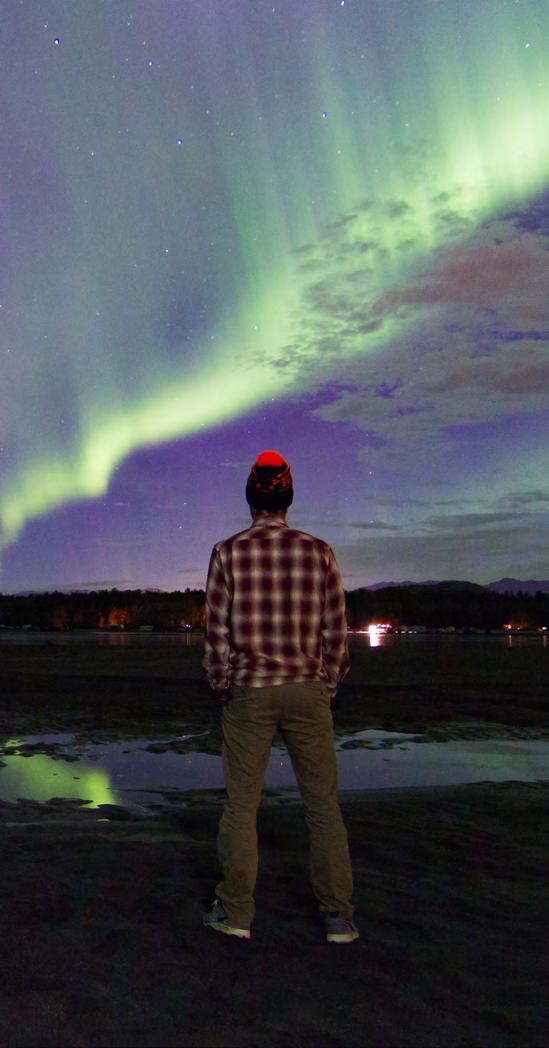
He met a small group of skaters and learned to slide, and his “need for speed” intensified. Casey honed his longboard skills as he experimented with board design and production. He wanted to grow his business, and when local skate shops rejected him, he moved in a different direction. With guidance and support from his mom, Casey opened 907Boards last summer at the age of 15.
Mom and son work closely together every day. Casey is the “research and development” guy, and Lisa thrives in the background, planning, organizing and marketing. Their collective goals are simple: provide first-class products and service, in a family-friendly environment, and grow the local longboard community.
Personally, Casey wants to learn from seasoned riders in the Lower 48 and bring the knowledge home to share with others. Mom dreams of getting Casey to a downhill race, like Maryhill, so he can evolve as a rider and make more business connections.
Casey bombs hills, rides any surface and terrain and finds humor in mom freaking out in the follow car. Lisa finds pleasure in watching Casey give public talks and handling customers. They challenge each other in ways they never dreamed possible.
The longboarding business, with its unique challenges and triumphs, is truly an adventure for the Conners. The struggles have been intense and incredibly rewarding for Casey and his mom. The effort to build 907Boards

has resulted in tremendous growth for every member of the family as they embrace new experiences. The financial and emotional strains of starting a new business, especially in an unfamiliar industry, are real. “What doesn’t kill you makes you stronger” comes to mind. Vandalism, harassing phone calls, social media attacks, police visits, theft, competition and other obstacles exist. Confronting the daily challenges of owning an independent skate shop solidifies the foundation of 907Boards. They continue to learn and grow with the skate world in their unique Alaskan way.
When he walks around with his board, Casey admits he deals with negative stereotypes of longboarding and skaters in general. This treatment came as a surprise. That’s partly what’s behind the
Longboard4Change branding efforts to remake the image of longboarders in Alaska and around the globe. As Lisa witnessed Casey’s natural ability to connect with kids and quickly engage them in a message, she saw an opportunity to use longboarding as a vehicle for change.
LB4C = Longboard4Change. The mission: help the world CHANGE in positive ways by sharing the stoke for longboarding and literacy. Longboard4Change shines a spotlight on longboarding and raises awareness of important literacy issues. The Conners want you to consider a new world in which every person learns to read.
Longboard4Change is a labor of love and a deeply personal mission for the Conner family. Raising awareness of important literacy issues and improving the reputation of longboarding are the goals. Longboards and literacy are a unique pairing, but a brilliant way to promote the sport and gain positive attention. 907Boards is a school business partner that gives the initiative access to young kids and a new generation of riders. Casey connects with kids on their level and assumes a mentor role versus an adult lecturing about reading or safety gear.
The Longboard & Literacy Art Contest kicked off in May in Alaska and has now gone global. Concrete Wave magazine and Aluminati Skateboards are collaborators on this project. Lucky

 Above - Casey Conner bombing hills near Anchorage.
Photo: Brad Carter
Above Right - Allyson Conner promoting Longboard4Change, Eagle River, Alaska.
Photo: Lisa Conner
Right - 907Boards is fully stocked – and stoked.
Above - Casey Conner bombing hills near Anchorage.
Photo: Brad Carter
Above Right - Allyson Conner promoting Longboard4Change, Eagle River, Alaska.
Photo: Lisa Conner
Right - 907Boards is fully stocked – and stoked.
winners will have their art emblazoned on cruisers and other merchandise to spread the stoke for longboarding and literacy throughout the world.
Local skaters in Alaska agree that it is the land of extremes, and though the longboard scene is limited in numbers, it’s flush with opportunity. Trey Milner, a lifelong Alaskan and dedicated skater, shared his opinion. “What irritates me is how we have amazing places to skate just around the corner and just out of town, really crazy areas,” he says, “[but] there are not a lot of people skating because the scene is so small here. It would be cool to see more people interested even though we have a short season – but it makes the summer even stronger. We just need more people that can push themselves out of their comfort zone, such as those with a love for adrenaline rushes.”
Trey enjoys downhill and freeride, but the majority of longboarders in Alaska are cruisers such as Brad Carter, a high school math teacher and advisor of a longboard club. He moved to Alaska
two years ago from South Carolina. Brad enjoys “cruising and the aspects of the sport that are peaceful and relaxing versus traditional skateboarding.” He thinks longboarding in Alaska is “really just beginning, and it’s mostly people using boards for transportation,” but knows the potential for growth in the state is huge.
Thane Barta, a high school junior and lifelong Alaskan, wants people outside Alaska to know that “You need to be more adventurous in Alaska. The weather is extremely unpredictable and creates challenges and requires patience.” He jokes, “There really are people up here riding. It’s not just a bunch of miners and igloo dwellers; we actually longboard here.”
When Trey Milner meets riders from the Lower 48, he speaks frankly about the challenges of Alaskan riding and living: “We have some crazy mountain runs,” he says. “The roads are rough due to the winters. It’s sketchy here. [But] gnarly roads in Alaska make you want to ride
more. All of our hills are really gnarly and snaky and not for beginners. The pavement is rough. If you can skate here, it’s something to be proud of, and the conditions prepare you for any place.”
But Trey also doesn’t hide the rewards Alaska offers. He believes it’s a great place for a certain kind of person: someone who “enjoys the little things like the sunrise and summers full of sun, plenty of nature and very little traffic. Anyone could love Alaska if they can appreciate the simpler things.”
Casey Conner believes the sport is just beginning in Alaska. That’s why he takes time each day to spread the stoke with customers, friends, kids he meets in schools, parents and even the general public.

If your travels take you to Anchorage, you can contact the Conners and inquire about Longboard Expeditions, their guided tours of local hills and hot spots.

 Far Left - Casey gets out of the shop for some on-board time.
Photo: Brad Carter
Above - Eagle River High School Longboard Club training day.
Photo: Brad Carter
Left - Casey Conner (red helmet) instructing kids at the Eagle River High School Longboard Club.
Far Left - Casey gets out of the shop for some on-board time.
Photo: Brad Carter
Above - Eagle River High School Longboard Club training day.
Photo: Brad Carter
Left - Casey Conner (red helmet) instructing kids at the Eagle River High School Longboard Club.
Ididn’t start doing downhill until I was 27 years old. From there, I did some slalom racing at La Costa and in Vail, Colorado, on the Another Roadside Attraction racing circuit. I am still addicted to the feeling you get when racing down a hill.
There were a lot of riders at Black Hill (in San Diego County) in 1975. This was where many manufacturers did their research and development. Pro riders came to test equipment and improve their skills. Companies such as Bahne, Cadillac Wheels, G&S, Tracker Trucks, Gullwing, Turner and Logan Earth Ski were at La Costa every week. Soon slalom cones showed up.
When I bought my first copy of SkateBoarder magazine in December 1976, I recall reading an article from Di Dootson. At the time, Di was heavily into the skate scene and I was strictly a newbie. Over the next several years I would see her articles and race reports. I was a little envious that Di was down in California, seemingly at the epicenter of all things skateboarding.


Fast-forward almost four decades later, and I finally got a chance to meet Di in person. We became friends, and at last year’s Catalina Island Classic I asked her to come on board to write a piece for CW. For those readers with long-term memories, reading Di’s words will feel like déjà vu. For our younger readers, I am hoping Di’s love for skateboarding will resonate with you. Her roots in skateboarding run deep, and her journey back to those roots is a tale worth telling. – Ed.
Having the type of personality to organize chaos, I ran those La Costa races for three years – not counting when we were at pro events around the country. With my experience at La Costa, I was hired to run slalom and downhill for many pro events: Long Beach, Akron, Kona Pro-Am, Sensation Basin WRAPS (Wild Radical Annual Party Session), Hang Ten, Cow Palace and others across the country.
I judged pro freestyle contests at Magic Mountain, Oceanside and more. I wrote many articles for SkateBoarder magazine – mostly competition coverage. I wrote the Pacific Skateboard Association Freestyle Contest Guidelines. I helped
Carving La Costa’s Black Hill on the weekends, 1975. Photo: Larry BalmaBarry Segall of SkaBo with the two tapings of the CBS TV show “Battle of the Sexes.” I wrote for Skate & Surf magazine. I worked with Henry Hester on the first two of his Hester Series bowl contests.
In 1976 I started the National Skateboard Review with Peggy Turner, wife of legendary board maker Bobby Turner, the designer of the Turner Summer Ski. The Review started partly because the racers kept asking how fast they went each week and I got tired of trying to remember and track the results and times for everyone. We printed the race results in a one-page handout called Skateboard Racing News. After a while Peggy didn’t want to continue, but I sure


did. She gave me the OK to carry on and I renamed the newspaper the National Skateboard Review
You have to remember this was in 1976: no cellphones, no email, no Internet. Long-distance calls could cost up to $30. The NSR became the voice for local skaters all over the country. It started as a one-page publication, but at its closure in 1979, it had grown to 22 pages. For that last issue I added color headlines (sounds easy now, but again, remember this was the ’70s). We published race results, photos, drawings, and letters from all over the country. Soon there was a regular section in the NSR called “Let’s Hear From,” where I would print what folks had sent me.
Three years later, I closed up shop in the summer of 1979 when companies, hit hard by the closure of skateparks, slowly stopped buying ads in the NSR. My last edition was April–May 1979. My heart was broken, and I left the Carlsbad area and moved to a little cabin in the hills in Jamul, east of San Diego. I returned to my previous career as a recreation therapist and packed away my photos, copies of the NSR and business records I had remaining from my days submerged in the skate industry. I remained friends with some folks from skateboarding, but in truth, I ran away. In doing so, I missed what happened in the ’80s and ’90s.
Local skate events had no voice for quite a long time. Not until the Internet began to flourish did amateurs have a way to promote themselves. At that point, they could self-publish. In 2004, I heard of a slalom race in La Costa. My first thought was, “What?! Without me?!” I found the spot and discovered all my old friends. I had missed Henry Hester’s slalom races that he held a few years earlier and was so bummed when I learned about them. But those were the only ones I missed. I was so happy to find that race in ’04.
An amazing thing happened at that race. People I didn’t even know came up to me to thank me for the National Skateboard Review. They explained how they would wait impatiently for the next issue to arrive. All those greetings brought tears to my eyes. The years fell away as I felt I was coming home to my skateboard family.
Since that race in ’04, I continue to make contact with people who sent me information for the NSR back in the day. Steve Caballero tells me the NSR was his first cover photo. Tim Stahl tells me that when he was an aspiring young photographer, my use of his photos started his career – he is a professional photographer today.
I had the honor of going to Washington, D.C. in 2013 to be part of Innoskate, a celebration of invention and creativity in skate culture. I was asked to submit a full collection of the NSR into the archives of the Smithsonian Institution. This honor was almost overwhelming. I thanked Jane Rogers, associate curator at the Smithsonian, for including me. Her reply? “You belong here.” So, all of you who made contributions to the National Skateboard Review, please know your words and photos are all in the Smithsonian. They liked me and my newspaper as an example of how innovative Americans changed the culture of America. They recognize skateboarding as an essentially American invention that has affected sport, art, fashion and design in the U.S.
It is clear that today’s skateboarders care about and respect the origins of their sport. My articles will bring you a historical vantage as we focus on skateboarding today.
Running cones at Box Canyon in 1976. That’s legendary surfer/skater Larry Bertlemann walking back up the hill. Photo: Larry Balma



Bwondering how many other skaters were around my age and still skateboarding. I was a member of several online skate bulletin boards like Skull & Bones, Bulldog Skates and Silverfish Longboarding, and as much as I enjoyed them, I thought something was missing: a place exclusively for skaters from the ’60s, ’70s and 80s, all on a site that would be easily accessible from mobile devices. Facebook seemed to be the answer.
So I started “Skaters Over 50” as a Facebook group. I had one or two friends around my age that skated, and a handful of people I friended on Facebook were old-timers too. There were already a bunch of skate groups on Facebook, but none fit the criteria I envisioned: a love for old-school skating, in an environment where mutual respect for other members was one of the only rules. The group started off slowly, but after growing to a couple hundred members, I realized I’d need some help. I had a few offers, but I chose my Facebook friend Eddie Katz. Eddie was a pro skater on the Logan Earth Ski team back in the 1970s, and he brought a needed balance to the group; I was just a mediocre skater even in my best days, and Eddie was a seasoned pro. I was the kid that read every issue of SkateBoarder magazine, and Eddie was one of the guys in the magazines. We wanted to make the
By David Lobergroup accessible for everyone our age: people who wanted to reminisce about the good old days; collectors; people who were still out there shredding all these years; and my favorite, guys (and gals) who were picking up a board again for the first time in decades. We also started a second group for members to buy/sell/ trade skate gear as well.
If you’re old enough to remember SkateBoarder from the 1970s, you know how it was THE focal point for skateboarding in that era. That’s what we’ve strived to be for our generation in the Internet age. And now, thanks to this column, we’ve expanded our reach a bit further (believe it or not, not everyone from my generation is on Facebook). I’m

looking forward to bringing readers of this great magazine into our world, as well as introducing Concrete Wave to the few members of our group who haven’t already read it.
I hope this has served as a good introduction as to what we’re all about. Check us out at www.skatersover50.com You don’t have to be a half-century old to join, but if you’ve been skating for a couple of decades, that’s close enough. I hope to see new faces soon.


Based out of Miami, Florida, the Skateboard Supercross Academy or SBSX Academy is where you go to learn how to shred and where you go to ride pumptracks. Founded by Jonathan Strauss and Alon Karpman, SBSX Academy is the educational side of skateboarding, where all wheel sports come together. You are familiar with soccer, basketball, football, tennis and swimming lessons; well, what about skateboard lessons?
One problem: There has been no progressive learning curriculum – until now. Everyone assumes you should be able to jump on a skateboard and ride and that’s all there is to it. Wrong. Just like other sports, skateboarding must be practiced, learned and trained to grow from beginner level to elite or pro level, and SBSX Academy makes this possible and attainable for any community.
Just like the ski slopes, SBSX Academy has built five training levels; Green (beginner), Yellow, Red, Blue and Black (elite/pro). Similar to the way karate belts are accomplished, SBSX Academy advances you to the next level when you graduate the previous one with all the appropriate exit skills learned and mastered.
Words and Photos by Sarah RassieurNo one said the open format of skateparks is bad, but doesn’t it get a little boring without direction? The Academies change that. Tricks are awesome, but first we learn to be strong skateboarders. Pushing, carving, foot-planting, bailing, riding switch, goofy, regular: all are learned in the Academies. Sending your child off to a skatepark can be
to ride a bike. At age 4 or 5 our mom or dad buys us a bike and we learn how to ride; it’s a custom we have. What if we did the same with skateboarding? Parents are as excited as kids to get them into the latest trending sport or activity. Skateboarding is a great way to strengthen our balance, hand-eye coordination and reflexes. Skateboarding is also a great way to commute through the neighborhood and get over to a friend’s house or get around a college campus. It is a skill that can apply in everyday life and be beneficial to everyone.
of asphalt, concrete or fiberglass. They can easily be built into the landscape, similarly to a bicycle path. So not only are the tracks fun, they’re also aesthetically pleasing, unlike skateparks, which often are just metal rails and ramps that get rusty and are placed haphazardly. There is a little more thought in the presentation of a pumptrack to be a shared space and not deteriorate the landscape and community surrounding it.
Each week has a specific, progressive lesson plan. Each level is about 18 weeks, or the full length of a semester of school. Parents love this after-school format, as it fits perfectly in a family’s busy schedule: school, skateboarding, dinner, bed, repeat.
dangerous and often distracting to other skateboarders if they lack “skatepark etiquette.” At the Academies we teach this, as well as good sportsmanship, which are commonly learned in other team/curriculum sports.
Good sportsmanship is crucial in skateboarding and all sports. Sports and fitness, after all, are about feeling good, staying healthy and fit and gaining self-respect. The practice of treating others as you would like to be treated, as mom and dad taught us, applies. We teach skateboarding etiquette like yelling, “Board up!” if your board rolls away from you so that all others nearby will avoid getting hit in the ankles. Another good example is the way we take turns and keep a flow or rhythm, aka sharing! Sharing is essential to good sportsmanship. Just like in other sports, no one likes a ball hog or a showoff.
Skateboard Supercross Academy is about so much more than just skateboard lessons. It is a sport, to be practiced and perfected, to keep healthy, happy and just have fun. Skateboarding is like learning

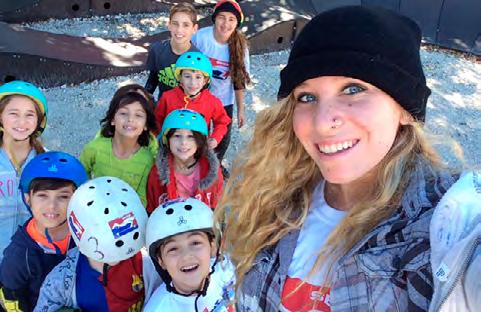
The structure of our classes consists of 40 minutes. Starting with a warm-up run and stretches, we then move on to learning two drills of the week. After learning the drills, we practice them on flat ground and then apply the skills to the pumptrack. What is a pumptrack? Velosolutions and SBSX have teamed up to build permanent and semi-permanent pumptracks out
Our students start at age 5 and go up to 13+. The students are enthusiastic to learn and come to us already passionate about skateboarding. With positive exposure to the advancement of the sport, it is not uncommon for kids to see skateboarding on ESPN, video tutorials and even in Hollywood films. We provide skateboards and scooters, but all wheeled sports, including bicycles and inline skates, are welcome on our tracks. The skills we teach apply to all wheels, not just to skateboarding.
One of the junior campers feels the pendulum of getting speed around the berms.Riders from Colombia, Spain, the USA and Puerto Rico tell you what they ride and why.
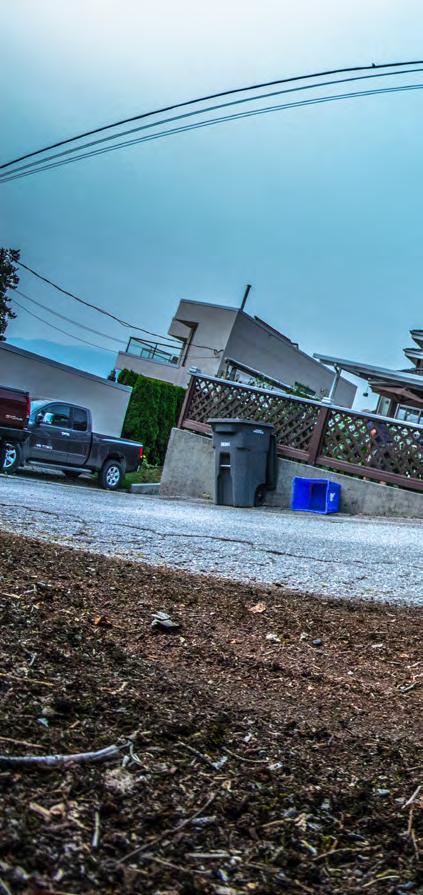
Orangatang Keanus. They’re predictable and light, althoughgoodnessI’ve[also]beenlovingsomeproto lately. I ride 176/46soAeratrucks,makestheOverland light and steady, great for a
I try to use one board for
doing tricks and stiff enough

Loaded Overland; it’s light for
everything. I usually ride the
to go a bit fast on it. I like the
little bit of everything. Predator
sometimes a fullface is needed.
usually ride with the FR7, but
helmets to protect the dome; I
Hey, I’m Mariela Santiago from Puerto Rico, and this is my setup. I’m riding a carbon “Spirit” from Moonshine Mfg. The board is 34” x 9”,aprettycompactandlightboard. One of my favorite features on this board is the urethane rails that run all around the board, and urethane truck mounts. It has multiple wheelbase options from 22.5” to 25.5”,andI’mridingitonthebiggest one. Canadian shredder Victoria Waddington helped to design this perfect whip alongside with Moonshine Mfg. To complete this perfect downhill machine I’ve got Aera 4 trucks in 48°, flipped for the OG lean, Venom bushings in 85A, Blood Orange grip tape and Biggie Hawgs wheels in 73 mm/80A.

inIlikeskatingalotofdifferentboards,butIwillalwayshaveaspot myheartforthissetup.TheSector9Arrow(LouisPillonimodel) dropsisidealforanyshredtasticadventure,withgreatconcaveandlittle with a functional tail.
Riha Signature Series trucks allow me to feel confident at speed

Remember when you didn’t havehillakicktailandhowyouspentyourtimelurkingoutontopofthe buddiesoratthebottomwaitingforthefollowcarlookingatallyour kickflippingandbackside180sslashingthesidewalk,and you’re like, “Aw, man, I have this board with no tail”? The Ronin

wheels in 80A give all the slide you could ask for. Stoked to beteamridingoneofmyidols’proboards,andcan’tthankthesponsorsand managers enough for all the help and support through theyears.Keepitrealandexpectnothingbutmaybesomeroadrash!
just as good as the precisions. Rider Approved Design Release
and in a slide; the support pin technology in the cast truck feels

Hailing from Asturias in the north of Spain, Pablo blends the best of freestyle/technical skating with longboarding. “I skate the new Forro model from Bastl Boards,” he says. “It is perfect for all kinds of tricks. The deck is completely stiff and I can do hard tricks and freeride with it.” Pablo uses Caliber trucks and says one of his favorite wheels is the Liam Morgan pro model from Blood Orange: “The 60 mm, 82A durometer wheels have a really smooth slide and are perfect for freestyle.” Special shout out to Buhoo Clothes, Toxic World Boardshop and Rompiente Norte.

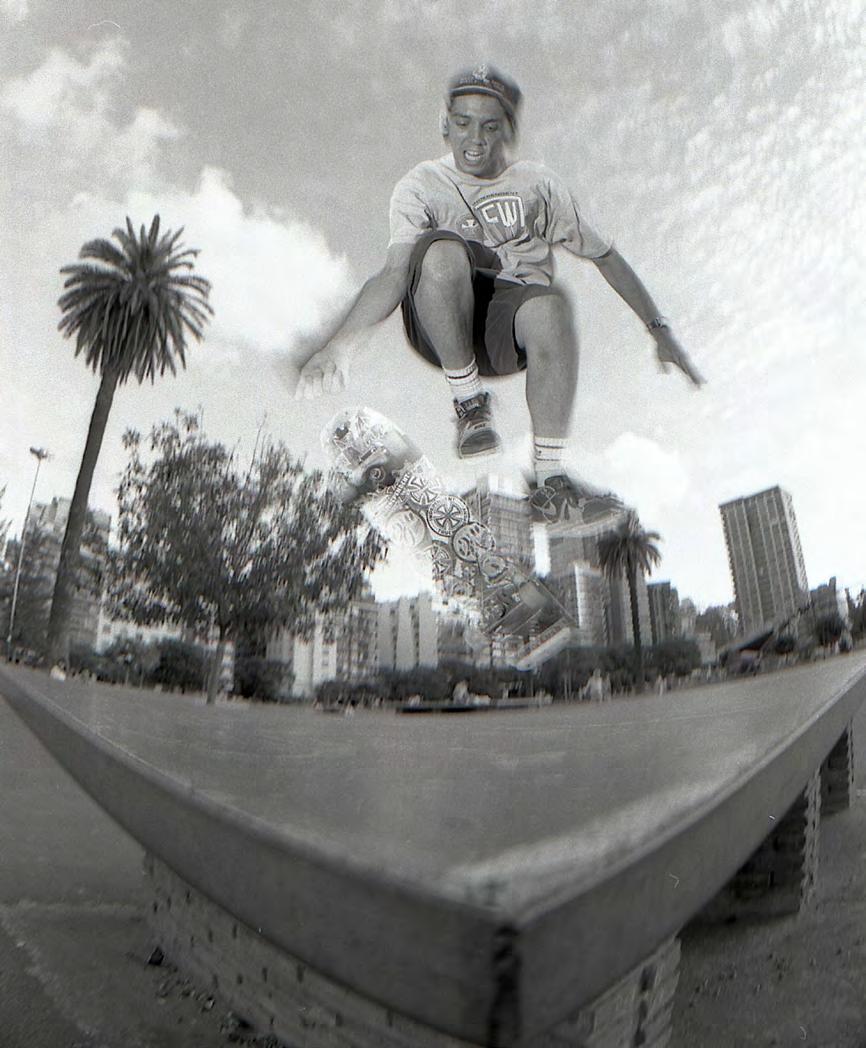 Henry Candioti (RIP) was known for his extraordinary style.
Photo: Gabriel Navarro
Henry Candioti (RIP) was known for his extraordinary style.
Photo: Gabriel Navarro
It sounds simple, right? To go out there in the world today and just express yourself however you want? But it’s not so easy anymore. There are so many false standards in this world, and kids today are plagued by the media, especially social media, to try to live up to the standards they believe other people are going to accept.
But where are the leaders? The innovators? The ones who walk tall and do whatever they want, look however they like to and stand out in the crowd, instead of just doing what it takes to fit in? These are the people that change the world. Michael Jackson, Elvis Presley and Bob Marley were all great singers who sent messages with their songs, but it was their overall presence that will be remembered forever.
Skateboarding has been around for a long time and has seen many evolutionary changes throughout each decade – from showing off how many 360s you could do in the ’70s, to seeing how high you could ollie in the ’80s, to learning all the flip tricks invented in the ’90s and nowadays doing them with ease over 12 stairs. The impossible has become the norm. Across the world, millions and millions of skaters can perform the norm, but who are the ones that stand out?
“You can watch 10 different people do the same trick, but only like the way one of them made it look,” says freestyle legend Kevin Harris. “It’s the style that matters more than the technicality.”
When you watch someone who is fairly new to skateboarding at the skatepark, you sometimes see them learn new tricks but not be happy with the way it looked. They will say yeah, I landed it, but it didn’t feel as good as the other guys make it look. But style comes from doing; it is natural, and the more you practice something the more confident you become, and with confidence your style will prevail.
Freestyle skateboarding is all about style. Every freestyle skater you see has his or her own distinct style: the way they dress, the way their hair and clothes are, and especially the way they move. And you can be sure that they all have grace in their movements. With only a few hundred freestylers in the world, they have to be unique, not just in their skating but in their everyday presence.
In 2012 an annual contest named the World Freestyle RoundUp was created in Vancouver, Canada. It invited top freestyle skateboarders from around the planet to come and show off for a random audience at the Cloverdale Rodeo & Country Fair while also competing for $10,000 in prize money. Hosted by Kevin Harris, one of the most stylish freestyle skaters ever, it gained recognition quickly and has had a great base of competitors each year.
From the legends like Russ Howell, Gunter Mokulys, Lynn Cooper and AJ Kohn to the younger new generation like Mike Osterman, Ryan Brynelson and Isamu Yamamoto, the World Round-Up is full of skill, excitement and especially style. “Style matters; it shows personality and mind,” says Stefan Albert from Germany. “It’s what you do and how you do it, and what you choose not to do. Skateboarding is expression. You’ve got your ideas, abilities, taste and mindset. Freestyle just means a guy
A particular, distinctive, or characteristic mode of action or manner of acting …
“Style matters...It’s what you do and how you do it, and what you choose not to do.”
with a board on flat ground, pure – never as fast, radical and spectacular as other aspects of skateboarding. It’s the dancing material art side of it.”
Stefan was the second recipient of a prestigious new award at the Round-Up, the Henry Candioti Skate-4-Fun Award. It was created to recognize the person at the Round-Up who best embodies skating with style – the one who just goes out and expresses himself (or herself) and shows their true style, without regard to winning the competition. Henry was one of the most stylish freestyle skateboarders of the 1980s; his way of moving from trick to trick with ease made everything he did look smooth, which attracted the eyes of many audiences. Henry always lived by the motto, “Do it for fun, or don’t do it at all,” says his brother Alejandro, who named the award in memory of Henry.

That’s the best part about freestyle: There are no obstacles, so your routines are a full expression of your inner self. When random people watch, they will appreciate smoothness and flow over the most technical trick you can do. “Style makes a freestyle skateboarder’s routine visually attractive, distinctive, appealing,” says Alejandro Candioti. “Whether it is smooth or aggressive, a freestyler with good style is always remarkable and surprising. Style adds beauty to a freestyle skateboarding run.”
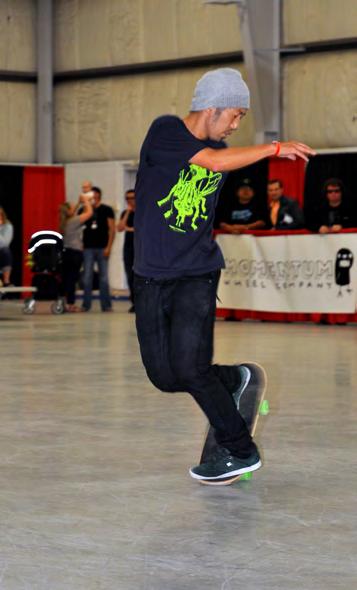
“Do it for fun, or don’t do it at all.”Takashi “TKC” Suzuki from Japan is an extremely creative skater. Photo: Jim Goodrich A stylish truck stand from Germany’s Stefan Albert. Photo: Jim Goodrich
Alejandro’s statement shows why the first winner of the award was Japanese skater Takashi Suzuki, who flows around the surface with unique and impossible maneuvers that hypnotize anyone who looks in his direction. No one can watch Takashi skate without being blown away by how he does what he does.


In today’s world it can be difficult to find your true self, but the World Round-Up allows people from all around the world to come out and express themselves for four days straight. True, it is a competition, but in the end it really doesn’t matter who wins … as long as everybody goes out with style.


At the end of August, it’s the end of vacations for French schoolboys and their parents. It’s also the best opportunity to ride the French Riviera without too much traffic. My friend Pierre Hardillier, the 2013 French downhill champion, and I decided to cross the South French Alps for a couple of days and search for the most beautiful roads to ride and shoot from mountain to sea.

The first destination was the highest paved road of Europe, the Col de la Bonnette –16 miles of riding, with a start above 9,000 feet. On that Saturday night, we had an appointment with Yvon Labarthe (a great street luge rider and filmer) and half a dozen other riders to film some runs lit by the full moon.
We arrived at the end of the afternoon and it didn’t take much time for Pierre to ride his board for a warm-up run. It was also an opportunity to meet the other riders and skate together until the sunset. This road was wonderful. It started from an altitude screen, then wound through alpine meadows and finished in a forest down the valley – all with perfect asphalt due to the recurrent passage of the Tour de France.

Once night fell and the moon rose, the real fun began. It had been a long time, but I used to shoot bike, ski, street luge and longboard by moonlight. I love the cold lighting and the feeling of being alone on the mountain. But this time, it was deeper than anything I had shot before. Imagine four riders starting at 50 mph on a road winding between cliffs and ravines, pursued by the follow-cam car, with nothing more than two LEDs under our boards and sparks from Crema Fire Pucks for light. It was a real crazy shoot for Yvon and our riders, Matthieu Zeder, Jules Horning, Max Sorek, Pierre Hardillier and me, which ended with the sunrise at the top of the pass. Amazing …
After this tiring night and a short nap, Max, Pierre and I decided to hit the road to the south, toward the sea. With Augustin Jouan-Montes’ tips and after two hours’ drive, we discovered the first spot of my dreams, the Rayol-Canadel pass. It was just the kind of place I was looking for – a little snaky road overlooking the sea, closed to traffic due to a landslide, with two miles of tranquility to ride, shoot and camp. Insane …




The next day, Max had another spot to show us, his home school spot. The Espigoulier Pass, around the city of Géménos and the Sainte Baume mountain, is well known by local bikers and drifters because of its width and its smooth asphalt with many hairpin turns. This road is a giant corkscrew to have fun, all in the typical landscape of Provence. Simply stunning …
The more this trip progressed, the more I was in heaven. Each spot was more beautiful than the last, and my pictures were the same. A real connection developed between the skaters and me, and we didn’t need to speak more to coordinate our actions. That was the perfect mix between riding and shooting, between nature and skateboarding.

After a good evening and a good night’s sleep at the workshop/home of Blackkross Longboards boss Greg Hunneguy, we decided to go back toward the sea, to the Ridge Road between La Ciotat and Cassis. This road has fascinated me ever since I saw it a few years ago. It’s a winding tourist road that runs on top of a cliff overlooking the sea, in a nature reserve. The sun began to drop, the two riders were hot to skate, and they soon regaled me with well-synchronized huge slides on the seabed side until sunset. Magical …
Before returning to Greg’s home for our last night, I had one last photo that kept running through my head, one that was not possible to produce in the Bonnette. I wanted to shoot sparks of Crema Fire closer. So this night shot was done by Max, with a French Riviera background.
I was overwhelmed. I had spent four memorable days with friends, shooting and riding in incredible landscapes. The next day we took all different directions, but we will keep in memory (cards?) those pure moments shared.
Skate is life, trip is life, life is happiness.
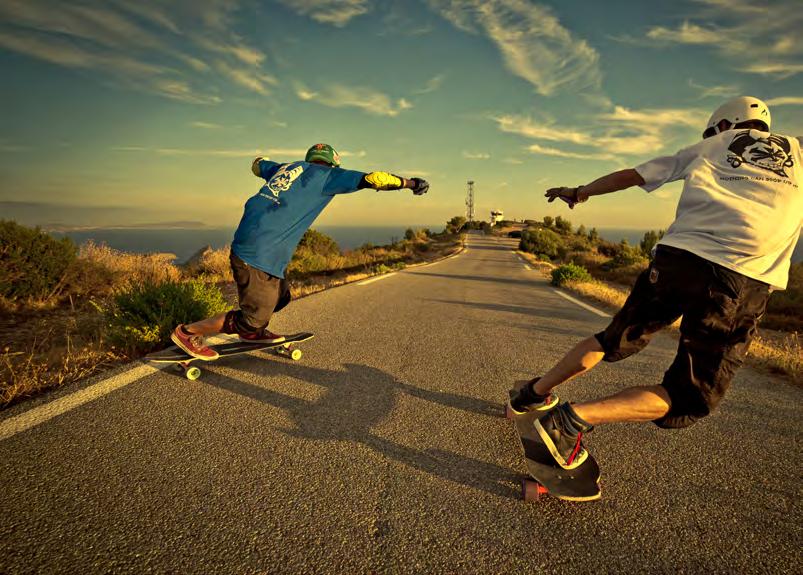



 BY CANDY DUNGAN
BY CANDY DUNGAN
own downhill-specific deck, with help from Blecha Boards Manufacturing. I call it the Sweet Tooth, because I finally found my sweet spot.
Guy or girl – it doesn’t matter. What matters for downhill and freeride decks is your shoe size, your stance and your preferences. For example, if you’re a downhiller with a men’s size 5 foot, then you want a board that’s roughly 8.75”–9.125” wide with moderate to intense concave. Why? Because then you can leverage both rails of your board for initiating turns and drifts.
Of course, no one board fits all. Even if you have the same shoe size and stance, you may prefer different lengths, widths, concaves and wheelbases. The trick is figuring out your body and what works best with it.

My feet are a women’s size 7, and my stance is small. I struggled to find a deck that fit me, so, rather than chop a board and lose concave, I decided to build my
My feet are short and narrow, with high arches. This creates a small foot-to-board contact patch, which translates to less leverage when leaning through turns or pushing out drifts. So I designed a deck that doubled my foot-to-board contact patch by fitting the board to my feet.
The Sweet Tooth is 8.75” wide, 33.75” long, with 7/8” rocker, ¾” radial concave and a 22.5”–24.5” wheelbase. It features a W bubble under my front foot for arch support and a T in back as both a foot lock and reference. It’s constructed with carbon fiber and a lightweight wood core to make it insanely stiff and light. This is my preference – I like riding a light board, so I can use minimal energy to maneuver it. Finally, I added ½” x ½” urethane rails around the entire deck, with a reinforced impact zone on the nose. This makes the Sweet Tooth practically indestructible and 100% waterproof.
Blecha makes custom carbon fiber/ urethane decks for less than $250, and you can pick up your own Sweet Tooth for $220. But if those aren’t options for you, here are a few other decks that may fit you well. Just remember, there’s no “one size fits all.” So make sure to stop in to your local shop and stand on different decks before purchasing your new best friend.
Rachel “Bagels” Bruskoff.Decks are gender-neutral.

Freya Jardine, a Texas rider for Team NoBull: “I like the Wolf Shark because it’s lightweight and small, which is perfect since I’m a small rider. The concave is perfect for downhill and freeriding. It’s super comfortable to stand on, and I love the Hollow Tech construction – it’s badass!”


Katie Boyer, from Colorado and Girls
Gone Fast: “As I like to call it, the ‘lady’ fortune. Just like the fortune but cute, like me! The moment I stepped on it, my feet were able to find all the sweet spots with ease, and I was more in control of my ride. It also has a fun kicktail option to pop little ollies at the top of the run or cruising downtown.”



Lilian Gutsch, from Germany and Root Longboards, designed the Nymphaea as her pro model. “Having a narrow board allows me to put more pressure on the edges, without having to change my feet position all the time,” she says. “Furthermore, the shorter wheelbase leads to more control. The Nymphaea is obviously narrower and shorter than most boards available on the market, but I want to emphasize that it’s not especially made for girls, but also for juniors and everyone who enjoys it.”
Specs: 32.28” long, 8.66” wide, 22.83”–25.59” wheelbase, top mount, medium concave, 4 mm micro drops, kicktail, flared wheel wells.
Specs: 32.5” long, 9.5” wide, 21.21”–23. 75” wheelbase, symmetrical design, top mount, micro drops, rocker, “peanut” W concave, Hollow Tech construction.
Specs: 33.5” long, 9.25” wide, 22.5”–24.75” wheelbase, directional, top mount, radial concave, kicktail, 4D cup wheel wells that create bacon-like waves of concave.
*Rayne also recommends the Brightside for women riders because it’s light, stiff and narrow with concave. Also, a woman designed the graphics – yeah, lady power!
> A larger wheelbase will make it easier for you to slide, and a smaller wheelbase will make it easier for you to grip. This is because the closer your back foot is to your back truck, the more grip and less slide you will get.
> For downhill and freeriding, you should be able to leverage both rails of your deck without moving your front foot. This means when you step on your board, your front foot is touching both the toeside and heelside edges at the same time. If you can feel the concave, and your board leans when you apply pressure to it, that counts as touching both rails, because you can leverage them without moving your foot.
> Downhill and freeride decks should not flex – the stiffer the better, because you don’t want your board bouncing over every crack, rock, slide and drift when you’re hustling down a hill.
Alyssa Hood, from Colorado and Rad Girls Krew: “The progressive concave allows for a lot of control. The deep pockets hold in your feet and create a great tucking platform. The small wheelbase and width create greater control for smaller people, and it can be used for many things. It’s a push, freeride and downhill board all in one!”
Specs: 34” long, 9.45” wide, 27.37”–28.12” wheelbase, double drop-through, ½” concave with “throughconcave” design to lock in your feet, a narrow neck allowing for narrow trucks.
The Vancouver Ladyboarders (VLB) is arguably the world’s largest concentrated female skate scene, with regular femaleoriented events and a strong social media presence. British Columbia skate races bring out more heats of local women than the strongest IDF race brings out international women. For me, as a female skater, this is a thing of envy. Most of us struggle to find other women to skate with, let alone race with.
However, it’s no surprise that British Columbia is leading the female scene, as it spearheaded the male scene with Coast Longboarding in the early 2000s. B.C. and Coast have birthed some of the greatest female legends in downhill skateboarding, such as “Skatie” Katie Neilson, Brianne Davies and Chiara Poscente.
Chiara says the early days of girls-skate dates were never about creating an “All Girls” community. “We were trying to get the girls out ripping so they gained the confidence to skate against the boys,” she says. “[We wanted to] show them that skateboarding is an equal-opportunity sport and ladies can shred with anyone they choose.”
Chiara raced the boys from about 2005 to 2011 and recalls the co-ed atmosphere and gender equality being a huge attraction for her, “Back when I was racing, especially in the very beginning, gender segregation wasn’t really a thing,” she says.
“In North America, there weren’t many ‘girls’ heats.’ There was just racing. Boy, girl, young, old … we all just got together and went fast because we loved it.”
Nowadays, female racing is a little different. Women are encouraged to race in women-only heats, which is a great way to get more women involved. However, it should be seen as a sub-class of, and stepping stone to, racing Opens. The groms use the junior division to gain experience before racing Opens, and women should do the same. The end goal should always be racing Opens because, as the B.C. women proved, women can skate as fast and hard as men.
The B.C. scene still holds bragging rights to producing the most female legends, but it’s now the scene’s female inclusiveness and numbers that have our attention. For women to be seen as equals in the longboarding community, we need both: women who are pushing boundaries and women who are just stoked, having fun and encouraging more women to skate. The number of women skating is as important as the top female skaters’ abilities.
Carrie Coffin and Bhakti James are two girls leading the numbers game in B.C. through the VLB. They believe that stoke, perseverance and events shaped the scene into the female skate hub that exists today.
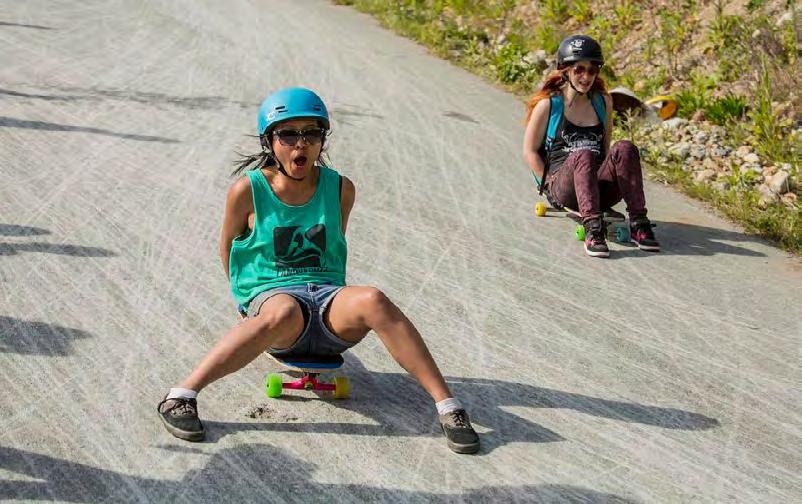 Erni Villanueva (left) and Amber Maetche’s expressions say it all!
Erni Villanueva (left) and Amber Maetche’s expressions say it all!
Here are 10 tips from Carrie and Bhakti about growing your own ladies’ crew:
1. Spread the stoke. Approach any girl with a board and invite her to skate with you and your crew. “Talk about it endlessly, and don’t be afraid to bother strangers,” Carrie says. “If she’s holding a board, she’s already interested in learning!”
2. Accept everyone! Downhill, freeride, push, cruise, dance, garages, freestyle, transition, street – it doesn’t matter. If they’re a girl and on a skateboard, then you want them! You can learn from their style and vice versa, because all skateboarding is fun.
3. Get Organized. VLB holds quarterly meetings at which the girls get together to discuss new ideas and events to help promote women’s skateboarding and grow the VLB community.
4. Plan girls’ skate sessions. For example, the VLB focused on Sunday N00b Sessions last year and Lady Parkades (Canadian garages) this year. They don’t run weekly structured events, but they do set events and stick to them. “Just do what you say you’ll do,” Bhakti says. “So if you plan an event, make sure it doesn’t fall through.”
5. Create a comfortable, friendly atmosphere that girls want to be a part of. Take them at their own pace, and be supportive throughout their journey. Always remember that the experience is the real reward.
6. Work with the local skate shop. Vancouver’s Flatspot Longboard Shop refers girls who visit their shop to VLB.
7. Work with local skate companies. Landyachtz, based in Vancouver, holds local, female-oriented skate events to help grow the female skate scene. VLB makes sure to attend these events to support, encourage and recruit more skater girls.
8. Work with the boys. The Coast guys support VLB by recruiting new girls and attending girls-skate sessions to provide advice and support. They even get involved on social media to spread stoke, share gear knowledge and encourage the lady skate.
9. Take advantage of social media. Use it to gather the women and share events, knowledge and good vibes. Encourage other girls to post when they’re going skating and to invite the rest of the girls. Impromptu skate sessions can be the most rewarding.
10. Don’t get discouraged. It takes time! The more girls who longboard, the more other girls will feel it’s comfortable and normal, Bhakti says. So, going from three girls to five took a year, and going from five to 10 took another year. The growth keeps multiplying as there are more girls skating and recruiting other girls. Remember that every woman counts. “Be patient,” Bhakti says, “because the first few people you get by your side are going to be the hardest to find.”
The girls hope in the future they will see VLB expanding in both demographics and territory. Bhakti wants to see more VLB lady groms (12–18 years old), and Carrie wants to see VLB expand to neighboring Canadian communities.
In the end, it comes down to one thing: Women supporting women.
VLB OG Crystal Fraser said it best: “The main success in the growth of the Ladyboarders is the fact that every single one of us has one thing in common: We love to shred. Let it be going fast, on a mini ramp, twirling down a hill or dancing, we always support and push each other to be the best we can be. It’s not just one person who keeps the whole thing going; it’s all of us in the community getting out there, spreading the word and having fun doing it!”

Bhakti:
I really look up to Anna O’Neill because even though she’s younger than me, she’s been in the skate scene for over a decade! She knows how to make people feel less scared and [how to] teach them in such a positive way that I really want to emulate. Anna can just say something and you’ll feel more calm and ready for a race or to try something new!
Carrie:
“Skatie” Katie Neilson inspired me when I first started. She was the first female racer I met, and the stories of her speed and style made me believe I too could try such a scary thing as racing a longboard. That list later expanded to include Brianne Davies and Chiara Poscente. They were two of the first women to skate Teutônia, one of the fastest roads in the world.
Bhakti James and Kady MessengeWhat would you say is the essence or theme surrounding your shop Soulriders?
Kurt: I came up with the idea for this shop while surfing at San Onofre when we lived in San Clemente. It’s like a car show at the beach every day, and it dawned on me that surfing and hot rods have been linked together throughout history. Because surfing and cars are connected, of course that means that skateboarding and cars are as well. After that you throw music in there and you have the icing on the cake! So, ultimately the store is kind of like a museum, with clothing, boards, magazines and memorabilia showcasing how surfing, skateboarding, hot rods and music are connected since the ’50s. On the walls we have a lot of vintage pieces that are just for show, but there is a lot of clothes, books, boards and vinyl for sale.
The city you’re located in is Santa Rosa, way north of L.A. What’s the vibe like? Well, Santa Rosa is north of San Francisco, and is kind of like the land that time forgot. I don’t mean that in a bad way, but it really is lost. There is no beach culture (not that there should be) and it is 35 minutes from the ocean. It rains a lot, it’s cold and it certainly doesn’t have a lot of surfers, although the surf can be quite good. There is a fair amount of skaters, but downhill is almost nonexistent even though it is very hilly. Hot rods and classic cars are very abundant, and the
rockabilly scene is pretty good because of that. So, the amount of people who would understand what the store is trying to portray is hit or miss. The other thing about Santa Rosa is that there isn’t much of a shopping area, contrary to its size of 170,000 people, and it is superexpensive to live here! Most people are struggling to just pay their rent because rental rates are up 40% in the last four years. For instance, a two-bedroom costs like $2,400 a month! But I like to think we have brought something unique to the town, and the people that do come in are very happy they found us. We actually moved here to be close to my wife’s mother. We figured if this concept could work here, it would do really good in an area that actually has a beach culture. So, we are actually fairly satisfied with the results so far, and we will see what the future holds.
A lot of people are finding retail pretty tough these days. What are some of the things you’re doing in order to find success?
There is no doubt we are a unique store. I have been in retail since 1980, so my whole life has revolved around helping people and treating them with respect. Customer service is our whole game. If people want something we don’t have, we will order it for them. But truly, most of the people coming to Soulriders are stoked with the offering that my wife and I have concocted with this concept.
You cannot get the items we have in here anywhere else, especially the mall. Then you throw in the love you get here, and it is a winning combination for us – because the people always leave with a smile. What keeps my wife and me in retail is seeing people happy when they leave our store!
You have a bit of a major background in retail. What is it about selling skateboards that gives you the greatest satisfaction?
I have been blessed to have been involved with great people my whole life, and I have tried to learn from all of them. I managed B.C. Surf and Sport for most of the 1980s and learned how to treat people on a retail level from Bruce Cromartie, who owns B.C. It was those years with Bruce that shaped my personality as it pertains to customer service. My dad was a huge influence, too, in that way. He was a salesman his whole life. In the ’90s I opened my own retail store called Brotherhood Board Shop and ran that with my wife until we sold it in 2008. We actually won best surf, skate and snow shop in the North Bay 10 years in a row. So you could say, I guess, that I have a lot of retail blood in my veins. Ultimately, since I have been skateboarding for 53 years and surfing for 43 years, it is my life. I love talking about the history of skate/surf and sharing that with others. I was lucky enough to compete professionally in the late ’70s, and again

in downhill in the late ’90s until 2003. I draw upon those experiences and my love of cars every day when I am talking to folks that come in the store, and it’s a blast.
What are some of the most interesting things you find in the shop?
We have a lot of clothing from surf/ skate brands that are connected in some way to hot rods and motorcycles. I only carry these certain brands because when you look to the roots of surfing you will always notice the classic personalities and cars that have been such a big influence on how we got to where we are today. That distinction cuts most of the corporate companies out of our mix instantly because the corporate surf and skate brands are now owned by stockholders who [couldn’t] care less. Most of these brands that we carry would never sell their stuff to the mall stores. My wife and I are collectors of memorabilia, and we own two hot rods. So we go to car shows all the time and vintage flea markets and pick up a lot of stuff along the way that relates to our love of this history. We have magazines from the ’60s to now, bicycles, surfboards, skateboards, original scooters from the ’50s that pre-dated skateboards and tons of posters and art everywhere that relate to a simpler time. Our skateboard section is full of old classic boards, both original and reissued, that you can purchase or just look at. Then of course we carry
Bustin Boards because they have an incredible variety of quality boards for every type of skateboarder. We do real well with Bustin!
The biggest surprise in the whole store, though, is how much vinyl we sell. And for sure music has been a big part of the history of surf, skate and hot rods. Just think about bands like the Beach Boys. They always sang about surfing, sidewalk surfing, hot rods and girls!
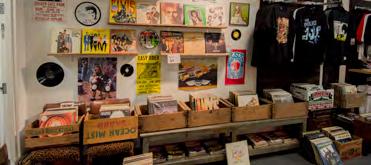

Amazon and other online retailers sell product, but you offer experience. What are some of the reactions you get when people walk into the shop? Still, to this day, people walk in and instantly say whoaaaa! Our store is certainly an experience. We have records playing, movies on the big screen and tons of vintage stuff to look at. Even if they don’t buy anything, they will walk away with at least a visual experience that is lasting. You don’t get that from shopping on Amazon or with online retailers.
In your opinion, what is the future for skate shops?


If you are a “skate shop,” then you have to compete with online retailers and mall stores. The only way you will ever compete with them is by giving the very best customer service possible, and love. You may laugh, but love isn’t hugging and kissing. It’s caring. Show

people that you really care about them and what they need – even if it’s an answer to a question! If you are a retailer and you’re into what you sell, you have the right stuff in stock and you have a good location, I think you have a real shot at succeeding. If you don’t follow that formula, and of course watch your overhead, you are going to have a tough time of it.
What kind of relationship do you have with the other skate shops around you? Well, I really only talk to a couple. Both of them are friends, and we get along just fine. That’s the only way to be, you know, ’cuz life is too short!
Any final thoughts or comments?
Retail isn’t for everyone. I think there are people meant to be in retail, and there are people who just thought they could be. Certainly there are people in retail just to make a buck. But if you go into retail because you want to do more than make money, you can actually change lives. Now that it is 2016, surfing and skateboarding have a very long and colorful history. It is that history that is really worth talking about because there are so many great stories. Don’t kid yourself; people are smart, and they can tell if you are really into what you’re preaching.











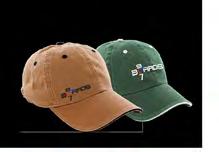

Christian Hosoi has had an incredible career in skateboarding. He turned pro at the age of 14 for Sims, then Alva, and eventually founded his own company, Hosoi Skateboards. We had a chance to catch up with Christian in late May.

The Hammerhead is a truly iconic shape. What led to releasing this particular issue with gold?
The Hosoi Hammerhead and Hosoi Skateboards just had its 30th anniversary, and I thought black and gold would be the appropriate colors to celebrate the anniversary. And gold has always been one of my all-time favorite colors!

The Limited Edition features your marked-up board graphic celebrating the wear and tear and personalization of a skateboard. What are your thoughts?
It’s all about connecting with your fans and getting creative. I wanted to do something that’s never been done before and issue a graphic of a board that was a personal rider that would be limited for people to own that looked real. It is truly something different.
Spending just a few minutes on your Facebook page reveals quite a bit about you. What gives you the greatest satisfaction when it comes to social
Kubo and Tony Alva made it easy to recognize style and to want be stylish! You are born with a certain style that no one can copy or learn by schooling. It’s called natural style.
media? Are there some posts that have surprised you?
I love the fact that I can share my life with the world and be open about who I am and what are the things that I’m into: faith, family, friends, skateboarding, sponsors – and I get to let people know what Hosoi Skateboards is up to organically with a platform that has no limits.
We just recently had the Skateboarding Hall of Fame awards. It’s always been a stellar event, but this year was much bigger than before. What are some of your thoughts about this event and how skateboarding honors its heroes and trailblazers?
The SHOF has definitely gone to another level because of Steve Van Doren and Vans, who brought it to an amazing venue to host the most prestigious award in skateboarding. It’s the highest honor to achieve in the legacy of a skateboarder’s career. So stoked for Eddie “El Gato” Elguera and his family for his induction!
When it comes to your kids and skateboarding, what is one memory that really sticks in your mind? The first thing that comes to my mind is watching my kids grow up in the skateboard world reminds me of myself and the possibilities that were in front of me. In addition to this is the freedom to choose whatever it is that I want to be or do because my father and mother gave me that freedom to have my own passions, ambitions and goals in my own life. I want to raise my children with that same principle. I guess I create memories with my children every day. So to pick one would be impossible!
Where did your sense of style come from? Do you feel it was something natural, or were there other things that helped nurture it? Hanging out with Jay Adams, Shogo
They just announced that skateboarding is going to be part of the Olympics in Japan in 2020. What is your initial reaction?
I’m OK with skateboarding in the Olympics. It’s going to be interesting how the rest of the world trains and competes against the nations that have been doing it for decades. I’m all about competition, so it just gets me hyped to watch the best in the world go at it for the gold!
Any final comments?
I am always humbled, honored and feel beyond blessed to be asked to do an interview. Thank you to Concrete Wave for the opportunity.
I have to say that I have true love, joy, peace and contentment, all because of my faith in Jesus Christ. That true love keeps me fighting for the lives of others to experience true love in their lives! Much love to my family and to all my sponsors who have supported me throughout my career and in life.
Christian’s father, Ivan, holds the original board while Christian shows off the reproductionRae is a freelance artist, illustrator and animator working mainly within the skateboarding and action/adventure sports industries. She also skates with the London-based all-girl skate crew NEFARIOUS and plays an active role in the London and Essex girls’ skate scenes.
Her passions are skateboarding and drawing, and she uses these to empower people; portraying super-awesome, radalicious beings that she hopes others can aspire to be like. Her style is inspired by trashy comics of the ’80s and ’90s, and her heroes include Mark “Fos” Foster, Mark Gonzales, Vanessa Torres and Tank Girl.
Rae has worked with Callus Skateboards, Blackriver Skates, Board of Media, I am Hip-Hop magazine and more to create deck designs, T-shirts, murals, stickers and prints that carry with them a sense of fun and humor wrapped up in neon colors and often macabre visuals. She also creates posters for girl skate events across London and loves showcasing gnarly women being unafraid of getting messed up while doing the things they love.

Website: lookslikerae.com
Email: ixrae108@gmail.com
IG/Twitter: @lookslikerae
FB: /lookslikerae
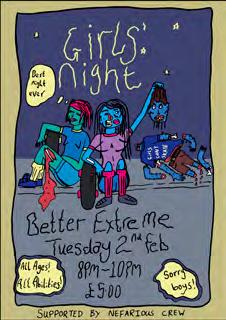



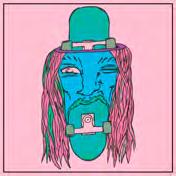
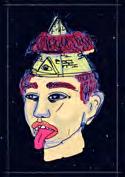

PUBLISHER/EDITOR: Michael Brooke - mbrooke@interlog.com
COPY EDITOR: Jonathan Harms
ART DIRECTOR/DESIGNER: Stacy Lowery
ASSOCIATE EDITOR: Joseph Friedmam
WEB DEVELOPER: Rick Tetz
INTERN: Danny Fedkenheuer
CONTRIBUTORS: Mark Short, Noelia Otegui, Daniel Marlatt, Jay Cagney, Tracey BartonHerishen, Ruby Tull, Doug Ward, Rachel Floyd, Scott Rowe, Kiefer Dixon, Brad Carter, Lisa Conner, Di Dootson Rose, Larry Balma, Tim Bee, David Lober, Sarah Rassieur, André Müller, Noah Gardner, Miguel Glez, Jose Mojena, Jeff Budro, Hippie Mike, Gabriel Navarro, Jim Goodrich, Pernet Alban, Olivier Bashonga, Gordon Ho, Kingsley Hurley, SoRadHarmony
We’d like to send a special thank you to Lisa Conner
HEAD OFFICE: 1136-3 Center Street, Suite 293, Thornhill, Ontario, L4J 3M8 Ph: 905.738.0804
CANADIAN DISTRIBUTION
Inward Supply 514-996-7138 Landyachtz 778-785-6855

Concrete Wave is published by North of La Jolla Inc. Subscriptions (6 issues) are US$26 FIRST CLASS or CAN$26. Address change? Mag not arriving? Contact us - don’t go postal. We can sort it out. mbrooke@interlog.com.
Publisher’s permission is required before reproducing any part of this magazine. The views and opinions expressed in Concrete Wave are not necessarily those of the publisher. Printed in the USA.

